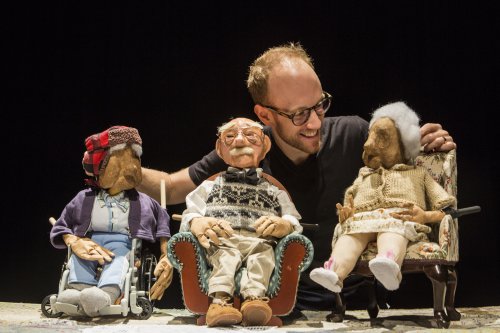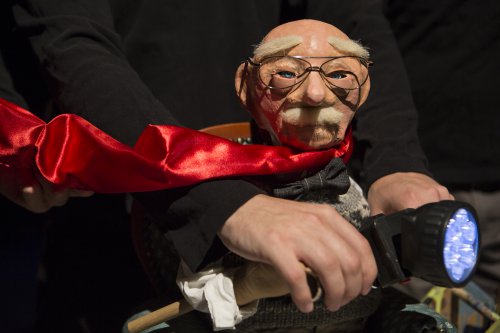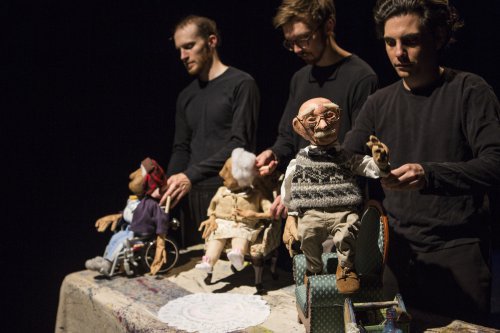Blossom
Puppet theater at its most uplifting -- Jim Henson Resident Artist Spencer Lott deftly captures the challenges of a painter gradually losing his mind.

Spencer Lott with puppets from “Blossom” (Photo credit: Maria Baranova)
[avatar user=”Cynthia Allen” size=”96″ align=”left” ] Cynthia Allen, Critic[/avatar]James Blossom’s spine gave out and a new one had to be replaced just before the opening night performance. Such is the world of puppetry. The
puppet armature was fixed in time; the show went on as planned. And, not only was the main character Blossom extraordinary, both in agility and expression, but he vividly brought to life the challenges of older age and being able to surmount them in the most unusual, positive ways. The play,
Blossom, is a remarkable tribute to how the world can be lived creatively in the here and now, despite not being able to keep track of the present.
Puppet artist, writer, director and filmmaker Spencer Lott directs Blossom — an inventive new Dixon Place commission. James Thurber’s The Secret Life of Walter Mitty is one of the inspirations behind Lott’s Blossom, in addition to Lott’s wife’s professional experiences with Alzheimer’s and other dementias.
Lott employs skillful puppetry, complementary video projections, innovative lighting and novel sound design to show the transitions between the present and make-believe. Five puppeteers (Robert Stevenson, Jamie Agnello, Rowan Magee, Chelsea Fryer, and Sam Jay Gold) carefully and exactingly portray the slow but sure disintegration of Blossom’s mind. Real-time and imaginary time are each given their own set pieces through which Blossom explores memories and in-the-moment relationships.

Puppet from “Blossom” designed by Spencer Lott (Photo credit: Maria Baranova)
James Blossom is a retired scenic painter and worked on old-time Hollywood films. The early-onset of Alzheimer’s at 63 years old forces him into a nursing home. Both Blossom and his daughter are confronted with trying and over-whelming life changes, as well as their own unresolved father-daughter issues. The daughter desperately tries to remain connected to her father, as he slips away, but to little avail.
Blossom increasingly cannot cope with living at Garden Ridge Nursing Home, and he loses himself in the memories of his past Hollywood glories. More and more, he finds solace in retreating to an era, decades ago, when he painted scenic backdrops and occasionally acted in films. Bygone cinematic adventures take over his everyday life and Blossom becomes the “star” of his films and not only a crew member.
As reality and memory become obscured, Blossom is jarred back to the present for a time when he forms a relationship with a nursing home staff member — a young aspiring art student (an empathetic and nurturing Chelsea Freyer). She encourages Blossom to continue to paint and coaxes him to create a biographic mural on his bedroom wall. But dementia eventually takes hold, and even painting cannot keep Blossom in the present and the real world.

Rowan Magee, Robert Stevenson and Nicholas Lehane with puppets designed by Spencer Lott for “Blossom” (Photo credit: Maria Baranova)
Various types of puppetry enable fluid transitions back and forth between reality and fantasy. Both rod and tabletop puppetry work in conjunction with each other to tell Blossom’s story from when he was a young man until he gets closer to death. During his five-year stay at the nursing home, Blossom increasingly looses mobility. Blossom begins as a rod puppet and then merges into a shadow puppet with voice-over narrations, as he is less and less able to move freely.
Chris Gabriel’s sound design adds texture to the present and the past. Alex Jainchill’s lighting design works beautifully with the changes from one reality to another. Lott uses an interesting conceit employing both puppet hand gestures as well as human hand gestures (from the same puppeteer) to emphasize specific story ideas — a human hand occasionally reaches out from or over the puppet hand to make a point.
Lott’s puppet designs for Blossom and the other nursing home patients are beautifully constructed. His costumes for each character are exemplary. Particular care is taken with Blossom’s wardrobe. His gray/black argyle sweater, bow tie, khaki pants and brown suede shoes, and wire rim glasses give Blossom a distinguished, almost professorial air. The other two nursing home patients wear clothes that convey their own particularities. One woman is dressed in a dowdy garb but wears bunny slippers. The second woman sports a matronly household dress but dons a Buffalo plaid hunter cap.
Simon Harding’s set designs enable the story to unfold in both hyperrealistic and surrealistic ways, as befitting qualities particular to dementia. But, it is really Lott’s extraordinary vision – writing the story, creating the puppets and costumes — that makes Blossom so memorable.
Lott had tremendous support right from the outset. He received a 2015 Henson Seed Grant to develop the play, and he put together the first draft of the script during a workshop. The workshop had a fantastic reception and Dixon Place commissioned the premiere of the full work from that initial workshop excerpt. Since the commission, he also received a 2016 Henson Project Grant to develop the play further. In an interview with AXS.com, Lott commented: “I get to make creative choices on color, shape, materials and texture, which all influence the puppet as a storytelling tool.”
Dixon Place continues to support and nurture cutting-edge experimental theater. Blossom is no exception — a fine addition to an already vibrant 30
plus years of exceptional underground and unique theater.
Blossom (Fridays & Saturdays: September 9, 10, 16, 17, 23 & 24 at 7:30pm)
Dixon Place,161a Christie Street (between Rivington and Delancey St.), in Manhattan
For tickets, call Dixon Place at 212-219-0736 or visit http://dixonplace.org/performances/blossom/
Running time: 80 minutes with no intermission






Leave a comment